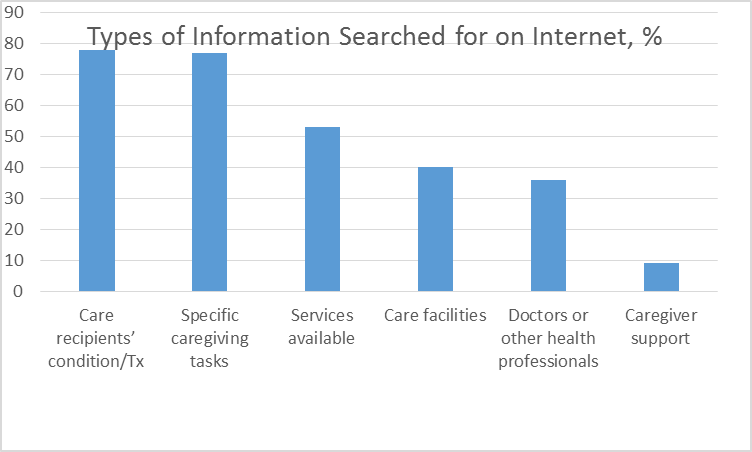In 2009, a sample of about 1,400 caregivers reported using a variety of sources for information about caring for their loved one. Frequent sources include the doctor (24%), their informal network (24%), aging services (14%), and a nurse (12%). Interesting, but perhaps not surprising, is that 27% also reported the Internet as a source of information. Five percent or less reported using other sources such as disease specific groups, their church, and the Veteran’s Administration. (Data from The National Alliance for Caregiving and AARP survey Caregiving in the U.S.).
Looking at all of the different information sources mentioned, caregivers fall into three distinct groups. The majority (68%, n=956) don’t actually look for much information at all with only a limited use of doctors, nurses, and aging services and virtually no use of other sources. Seventeen percent (n=226) rely almost entirely on their informal network, while 16% (n=215) rely entirely on the Internet for information.
Among those who used the Internet to look for caregiving information in the 12 months before the survey, the majority looked for information on the care recipient’s condition or treatment (78%, n=544), information on specific caregiving tasks (77%, n=540), or available services (53%, n=382). Forty percent (n=274) looked for information on care facilities and 36% (n=257) for information on doctors or other health professionals. Only 9% (n=76) reported looking for caregiver support.
Again, in terms of online information searches, caregivers fall into three groups. Forty nine percent used the Internet, but didn’t specifically look for any of the above types of information and 28% looked mainly for information on the condition or treatment. Another 23% looked for all types of information online with a particular focus on the condition or treatment, available services, and care facilities.
These data raise two main questions for me. First, why are the majority of people not looking for more information? There may be any number of reasons, including the possibility that they are getting all of the information they need. But, if you’ve had to deal with the health care system recently, you know that coordinating care for yourself or a loved one can be a full time job. Just at the time when you should be resting and healing, you are running from appointment to appointment; making phone calls to doctors, pharmacists, and insurance companies; and sorting through a deluge of bewildering information at a whirlwind pace to make sometimes life-changing decisions. It is a daunting task at best and for many downright impossible. My guess is that caregivers and patients don’t know where to go for information or are simply too overwhelmed to deal with it. It can be tempting to sit back and do what the professionals say without question. Quality care requires professionals to talk to each other and patients to be informed and actively involved.
Second, for those who rely on their informal network or the Internet for information, what kind of information are they getting and how are they evaluating the credibility and usefulness of what they receive? The Pew Research Center reported in 2013 that 59% of U.S. adults looked online for health information in the past year (substantially more than the 2009 numbers above suggest. That difference may be due to sampling or because they were asking about the health of the respondent, rather than someone they were caring for. It might also be, however, that the number of people using online health information is increasing. And, I would argue, that’s not necessarily a bad thing – as long as we are smart consumers and use what we learn to inform conversations with our health care providers.
Where do you get your health information? How do you decide what online health information is credible? How do you use that information?



Leave a Reply